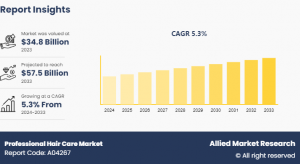The Automotive Turbocharger Market plays a crucial role in enhancing internal combustion engine performance by boosting power output, fuel efficiency, and reducing emissions. Turbochargers leverage exhaust gas energy to compress air intake, enabling engines to deliver more power without increasing displacement. Key market trends include stricter emissions regulations, engine downsizing, and integration with hybrid vehicles.
NEWARK, Del , Sept. 18, 2024 (GLOBE NEWSWIRE) — Global sales of automotive turbochargers are expected to reach USD 18,217.7 million in 2024, with projections indicating a rise to USD 45,561.7 million by 2034, representing a compound annual growth rate (CAGR) of 9.6% during the forecast period. In 2023, the revenue from automotive turbochargers was reported at USD 16,622.0 million, and it is anticipated to experience year-over-year growth of 9.4% in 2024.
Market Trends:
Emission Regulations Compliance: Stricter emissions regulations worldwide drive the adoption of turbocharging technology as a cost-effective means to improve engine efficiency, reduce fuel consumption, and lower emissions of greenhouse gases and pollutants such as carbon dioxide (CO2) and nitrogen oxides (NOx).
Downsizing and Engine Efficiency: Automotive manufacturers increasingly utilize turbochargers to downsize engines while maintaining or enhancing performance, achieving fuel economy gains, and meeting regulatory requirements without sacrificing power or driving dynamics.
Hybridization and Electrification: The integration of turbochargers with hybrid powertrains and electrified vehicles, including mild hybrids, plug-in hybrids (PHEVs), and electric vehicles (EVs), presents opportunities to enhance overall system efficiency, power delivery, and performance.
Aftermarket Performance Upgrades: Enthusiast demand for aftermarket turbocharger kits and performance upgrades continues to drive aftermarket sales, offering enthusiasts the ability to increase engine power and torque output beyond factory specifications.
Market Drivers:
Fuel Efficiency and Performance: Turbochargers enable automotive manufacturers to achieve fuel efficiency improvements and performance enhancements by increasing engine power density, optimizing combustion efficiency, and reducing pumping losses.
Regulatory Pressure: Compliance with stringent fuel economy and emissions regulations, including Corporate Average Fuel Economy (CAFE) standards in the United States and Euro emissions standards in Europe, drives the adoption of turbocharging technology to meet regulatory targets.
Consumer Demand for Power: Consumer preferences for vehicles with enhanced performance, acceleration, and driving dynamics fuel the demand for turbocharged engines, particularly in segments such as sports cars, luxury vehicles, and performance-oriented models.
Global Vehicle Production Growth: The steady growth in global vehicle production, particularly in emerging markets, drives the demand for turbochargers as standard equipment in gasoline and diesel-powered vehicles across various vehicle segments.
Browse full Report: https://www.futuremarketinsights.com/reports/global-automotive-turbochargers-market
Country-wise Insights
| Countries | Value CAGR (2024 to 2034) | |
| India | 10.50% | |
| South Korea | 10.10% | |
| Germany | 9.70% | |
| The USA | 9.40% | |
| China | 9.10% | |

Key Players:
Major players in the automotive turbocharger market include turbocharger manufacturers, automotive component suppliers, and aftermarket parts manufacturers.
Leading companies in this sector include BorgWarner Inc., Honeywell International Inc. (Garrett Motion), Mitsubishi Heavy Industries Ltd., Continental AG, Cummins Inc., IHI Corporation, and Eaton Corporation plc, among others.
Challenges:
Turbo Lag and Response: Addressing turbo lag, the delay between throttle input and boost response, remains a challenge for turbocharger manufacturers, particularly in low-speed and transient driving conditions, requiring innovations in turbocharger design and control strategies.
Heat Management and Durability: Managing heat dissipation and ensuring component durability under high exhaust gas temperatures, pressure differentials, and operating conditions pose challenges for turbocharger materials, coatings, and cooling systems.
Cost and Affordability: Balancing cost considerations with performance requirements and regulatory compliance poses challenges for automotive OEMs and turbocharger suppliers in developing cost-effective turbocharging solutions without compromising quality or reliability.
Technology Integration and Compatibility: Integrating turbocharging technology with other vehicle systems, such as engine management, exhaust aftertreatment, and thermal management, requires coordination, compatibility testing, and system optimization to ensure seamless operation and performance.
Overall, the automotive turbocharger market is driven by factors such as emission regulations compliance, fuel efficiency objectives, technological advancements, and consumer demand for power and performance. Continued innovation, investment in research and development, and collaboration with automotive OEMs and suppliers will be essential for turbocharger manufacturers to address challenges, capitalize on market opportunities, and maintain a competitive edge in the automotive industry.
Buy Now: https://www.futuremarketinsights.com/checkout/135
Key Segmentation
By Vehicle Type:
The vehicle Type segment is further categorized into Passenger Cars, LCVs, HCVs, Agriculture Machinery, and Construction Machinery.
By Product Type:
The Product Type segment is classified into Waste Gate, VGT, and Twin Turbo.
By Fuel Type:
The Fuel Type segment is categorized into Gasoline and Diesel.
By Sales Channel:
The application segment is categorized into OEM and Aftermarket.
By Actuator:
The Actuator segment is categorized into Hydraulic, Pneumatic, and Electric.
German Translation:
Es wird erwartet, dass der weltweite Umsatz mit Turboladern für Kraftfahrzeuge im Jahr 2024 18.217,7 Mio. USD erreichen wird, wobei die Prognosen auf einen Anstieg auf 45.561,7 Mio. USD bis 2034 hindeuten, was einer durchschnittlichen jährlichen Wachstumsrate (CAGR) von 9,6 % im Prognosezeitraum entspricht. Im Jahr 2023 wurde der Umsatz mit Turboladern für Kraftfahrzeuge mit 16.622,0 Mio. USD angegeben, und es wird erwartet, dass er im Jahr 2024 ein Wachstum von 9,4 % gegenüber dem Vorjahr verzeichnen wird.
Markttrends:
Einhaltung von Emissionsvorschriften: Weltweit strengere Emissionsvorschriften treiben die Einführung der Turboladertechnologie als kostengünstiges Mittel zur Verbesserung der Motoreffizienz, zur Senkung des Kraftstoffverbrauchs und zur Senkung der Emissionen von Treibhausgasen und Schadstoffen wie Kohlendioxid (CO2) und Stickoxiden (NOx) voran.
Downsizing und Motoreffizienz: Automobilhersteller setzen zunehmend Turbolader ein, um Motoren zu verkleinern und gleichzeitig die Leistung beizubehalten oder zu verbessern, den Kraftstoffverbrauch zu senken und die gesetzlichen Anforderungen zu erfüllen, ohne die Leistung oder Fahrdynamik zu beeinträchtigen.
Hybridisierung und Elektrifizierung: Die Integration von Turboladern in Hybridantriebe und elektrifizierte Fahrzeuge, einschließlich Mild-Hybride, Plug-in-Hybride (PHEVs) und Elektrofahrzeuge (EVs), bietet Möglichkeiten zur Verbesserung der Gesamtsystemeffizienz, der Leistungsentfaltung und der Leistung.
Aftermarket-Leistungssteigerungen: Die Nachfrage von Enthusiasten nach Aftermarket-Turbolader-Kits und Leistungssteigerungen treibt die Aftermarket-Verkäufe weiter an und bietet Enthusiasten die Möglichkeit, die Motorleistung und das Drehmoment über die Werksspezifikationen hinaus zu steigern.
Markttreiber:
Kraftstoffeffizienz und -leistung: Turbolader ermöglichen es Automobilherstellern, die Kraftstoffeffizienz und die Leistung zu verbessern, indem sie die Motorleistungsdichte erhöhen, den Verbrennungswirkungsgrad optimieren und die Pumpverluste reduzieren.
Regulatorischer Druck: Die Einhaltung strenger Vorschriften für Kraftstoffverbrauch und -emissionen, einschließlich der CAFE-Normen (Corporate Average Fuel Economy) in den USA und der Euro-Emissionsnormen in Europa, treibt die Einführung der Turboladertechnologie voran, um die gesetzlichen Ziele zu erreichen.
Verbrauchernachfrage nach Leistung: Die Präferenzen der Verbraucher für Fahrzeuge mit verbesserter Leistung, Beschleunigung und Fahrdynamik treiben die Nachfrage nach Turbomotoren an, insbesondere in Segmenten wie Sportwagen, Luxusfahrzeugen und leistungsorientierten Modellen.
Wachstum der weltweiten Fahrzeugproduktion: Das stetige Wachstum der weltweiten Fahrzeugproduktion, insbesondere in den Schwellenländern, treibt die Nachfrage nach Turboladern als Serienausstattung in benzin- und dieselbetriebenen Fahrzeugen in verschiedenen Fahrzeugsegmenten an.
Länderspezifische Einblicke
| Länder | Wert-CAGR (2024 bis 2034) | |
| Indien | 10.50% | |
| Südkorea | 10.10% | |
| Deutschland | 9.70% | |
| The USA | 9.40% | |
| China | 9.10% | |
Hauptakteure:
Zu den Hauptakteuren auf dem Markt für Turbolader für Kraftfahrzeuge gehören Hersteller von Turboladern, Zulieferer von Automobilkomponenten und Hersteller von Ersatzteilen.
Zu den führenden Unternehmen in diesem Sektor gehören unter anderem BorgWarner Inc., Honeywell International Inc. (Garrett Motion), Mitsubishi Heavy Industries Ltd., Continental AG, Cummins Inc., IHI Corporation und Eaton Corporation plc.
Herausforderungen:
Turboloch und Ansprechverhalten: Die Behebung des Turbolochs, d. h. der Verzögerung zwischen Gaseingabe und Ladedruckverhalten, bleibt eine Herausforderung für die Hersteller von Turboladern, insbesondere bei niedrigen Drehzahlen und transienten Fahrbedingungen, die Innovationen bei der Konstruktion des Turboladers und den Steuerungsstrategien erfordern.
Wärmemanagement und Haltbarkeit: Das Management der Wärmeableitung und die Gewährleistung der Langlebigkeit der Komponenten bei hohen Abgastemperaturen, Druckunterschieden und Betriebsbedingungen stellen Herausforderungen für Turboladermaterialien, Beschichtungen und Kühlsysteme dar.
Kosten und Erschwinglichkeit: Der Abwägung von Kostenüberlegungen mit Leistungsanforderungen und der Einhaltung gesetzlicher Vorschriften stellt Automobilhersteller und Turboladerlieferanten vor Herausforderungen, wenn es darum geht, kostengünstige Turboladerlösungen zu entwickeln, ohne Kompromisse bei Qualität oder Zuverlässigkeit einzugehen.
Technologieintegration und Kompatibilität: Die Integration der Turboaufladetechnologie in andere Fahrzeugsysteme, wie z. B. Motormanagement, Abgasnachbehandlung und Wärmemanagement, erfordert Koordination, Kompatibilitätstests und Systemoptimierung, um einen nahtlosen Betrieb und eine reibungslose Leistung zu gewährleisten.
Insgesamt wird der Markt für Turbolader für Kraftfahrzeuge von Faktoren wie der Einhaltung von Emissionsvorschriften, Kraftstoffeffizienzzielen, technologischen Fortschritten und der Nachfrage der Verbraucher nach Leistung und Leistung bestimmt. Kontinuierliche Innovation, Investitionen in Forschung und Entwicklung sowie die Zusammenarbeit mit Automobilherstellern und -zulieferern werden für Turboladerhersteller von entscheidender Bedeutung sein, um Herausforderungen zu meistern, Marktchancen zu nutzen und einen Wettbewerbsvorteil in der Automobilindustrie zu erhalten.
Wichtige Segmentierung
Nach Fahrzeugtyp:
Das Segment Fahrzeugtyp wird weiter in Pkw, leichte Nutzfahrzeuge, schwere Nutzfahrzeuge, Landmaschinen und Baumaschinen unterteilt.
Nach Produkttyp:
Das Segment Produkttyp wird in Waste Gate, VGT und Twin Turbo unterteilt.
Nach Kraftstoffart:
Das Segment Kraftstoffart wird in Benzin und Diesel unterteilt.
Nach Vertriebskanälen:
Das Anwendungssegment wird in OEM und Aftermarket eingeteilt.
Nach Aktuator:
Das Aktuatorsegment wird in Hydraulik, Pneumatik und Elektrik unterteilt.
Authored By
Nikhil Kaitwade (Associate Vice President at Future Market Insights, Inc.) has over a decade of experience in market research and business consulting. He has successfully delivered 1500+ client assignments, predominantly in Automotive, Chemicals, Industrial Equipment, Oil & Gas, and Service industries.
His core competency circles around developing research methodology, creating a unique analysis framework, statistical data models for pricing analysis, competition mapping, and market feasibility analysis. His expertise also extends wide and beyond analysis, advising clients on identifying growth potential in established and niche market segments, investment/divestment decisions, and market entry decision-making.
Nikhil holds an MBA degree in Marketing and IT and a Graduate in Mechanical Engineering. Nikhil has authored several publications and quoted in journals like EMS Now, EPR Magazine, and EE Times.
Explore FMI’s related ongoing Coverage in Automotive Domain:
The global low rolling resistance tire market size is anticipated to reach USD 20.5 billion in 2024. It is predicted to surge at a CAGR of 11.7% during the assessment period.
The global golf cart market size is estimated to reach USD 2,194 million in 2024. It is predicted to rise at a CAGR of 4.8% during the assessment period to reach a value of USD 3,512.1 million by 2034.
Sales of automotive stampings in India are estimated to be worth USD 5,109.3 million in 2024. The industry is anticipated to reach a value of USD 9,416 million by 2034 and rise at a CAGR of 6.3% over the forecast period between 2024 and 2034.
The global automotive cylinder liner market size is projected to reach USD 5,182.9 million in 2024. It is predicted to rise at a CAGR of 6.7% during the forecast period to reach a value of USD 9,884.3 million by 2034.
The global automotive plastic market size is anticipated to reach USD 75,188.3 million in 2024. It is projected to surge at a CAGR of 6.8% during the forecast period of 2024 to 2034.
The global automotive interior leather market is estimated to be worth USD 23.1 billion in 2024. It is anticipated to reach a value of USD 37.3 billion by 2034.
The global bicycle chain market size is projected to reach USD 7,610.2 million in 2024. It is estimated to surge at a CAGR of 4.6% during the forecast period and is anticipated to attain a value of USD 11,940.6 million by 2034.
The global automotive smart antenna market size reached USD 6,643.2 million in 2023. The industry is projected to exhibit a Y-O-Y growth of 8.9% in 2024 and reach USD 7,247.7 million in the same year.
The global automotive exhaust manifold industry value reached USD 10,052 million in 2023. Over the forecast period, the value is anticipated to rise at 3.7% CAGR.
he global dual clutch transmission market size was reported at USD 77,849.1 million in 2019. It is anticipated to witness a Y-O-Y growth of 8.6% in 2024 and attain a value of USD 98,736.5 million in the same year.
About Future Market Insights (FMI)
Future Market Insights, Inc. (ESOMAR certified, recipient of the Stevie Award, and a member of the Greater New York Chamber of Commerce) offers profound insights into the driving factors that are boosting demand in the market. FMI stands as the leading global provider of market intelligence, advisory services, consulting, and events for the Packaging, Food and Beverage, Consumer Technology, Healthcare, Industrial, and Chemicals markets. With a vast team of ~400 analysts worldwide, FMI provides global, regional, and local expertise on diverse domains and industry trends across more than 110 countries.
Contact Us:
Future Market Insights Inc.
Christiana Corporate, 200 Continental Drive,
Suite 401, Newark, Delaware – 19713, USA
T: +1-845-579-5705
For Sales Enquiries: [email protected]
Website: https://www.futuremarketinsights.com
LinkedIn| Twitter| Blogs | YouTube

Legal Disclaimer:
EIN Presswire provides this news content “as is” without warranty of any kind. We do not accept any responsibility or liability
for the accuracy, content, images, videos, licenses, completeness, legality, or reliability of the information contained in this
article. If you have any complaints or copyright issues related to this article, kindly contact the author above.
![]()
Originally published at https://www.einpresswire.com/article/744470297/automotive-turbochargers-market-outlook-fuel-efficiency-emission-regulations-and-ev-adoption-to-unlock-growth-potential-future-market-insights




